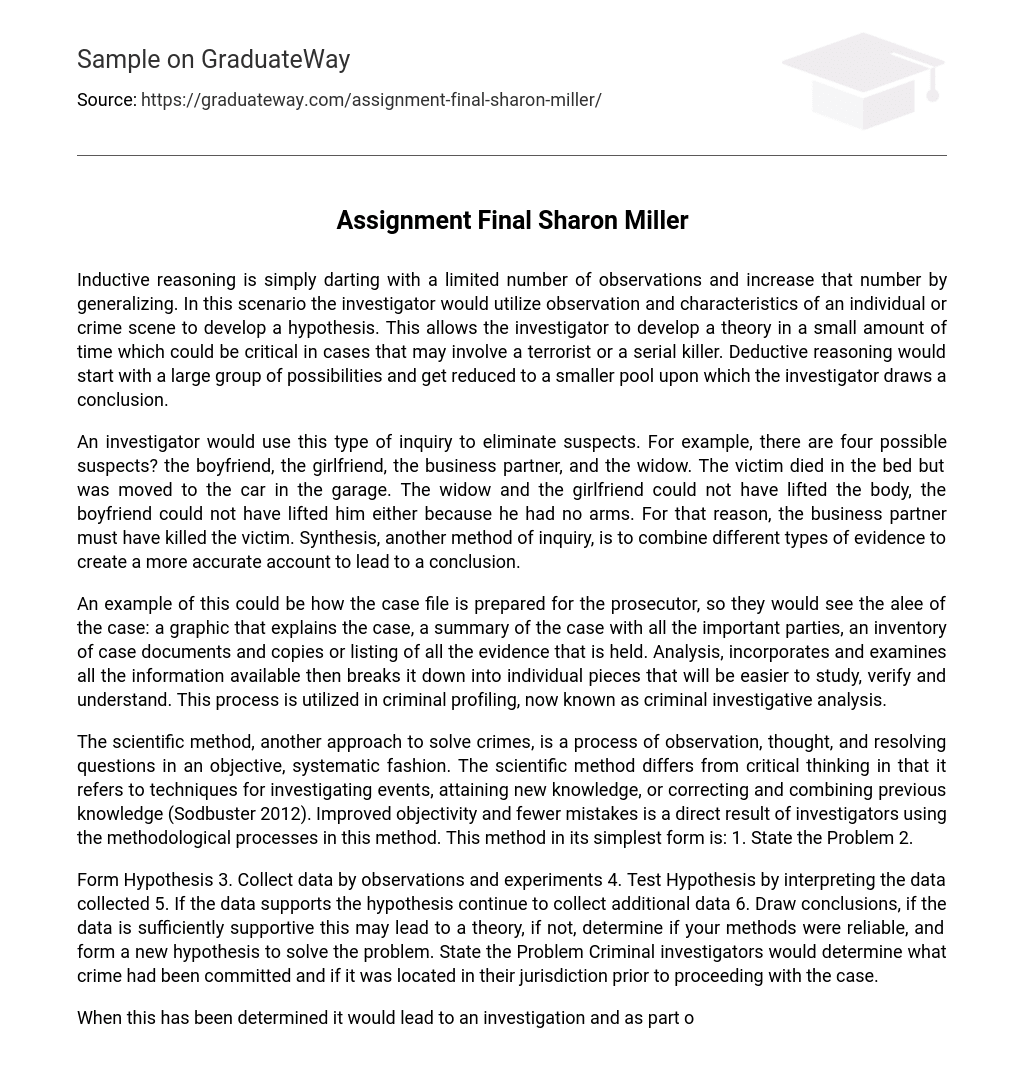Inductive reasoning is simply darting with a limited number of observations and increase that number by generalizing. In this scenario the investigator would utilize observation and characteristics of an individual or crime scene to develop a hypothesis. This allows the investigator to develop a theory in a small amount of time which could be critical in cases that may involve a terrorist or a serial killer. Deductive reasoning would start with a large group of possibilities and get reduced to a smaller pool upon which the investigator draws a conclusion.
An investigator would use this type of inquiry to eliminate suspects. For example, there are four possible suspects? the boyfriend, the girlfriend, the business partner, and the widow. The victim died in the bed but was moved to the car in the garage. The widow and the girlfriend could not have lifted the body, the boyfriend could not have lifted him either because he had no arms. For that reason, the business partner must have killed the victim. Synthesis, another method of inquiry, is to combine different types of evidence to create a more accurate account to lead to a conclusion.
An example of this could be how the case file is prepared for the prosecutor, so they would see the alee of the case: a graphic that explains the case, a summary of the case with all the important parties, an inventory of case documents and copies or listing of all the evidence that is held. Analysis, incorporates and examines all the information available then breaks it down into individual pieces that will be easier to study, verify and understand. This process is utilized in criminal profiling, now known as criminal investigative analysis.
The scientific method, another approach to solve crimes, is a process of observation, thought, and resolving questions in an objective, systematic fashion. The scientific method differs from critical thinking in that it refers to techniques for investigating events, attaining new knowledge, or correcting and combining previous knowledge (Sodbuster 2012). Improved objectivity and fewer mistakes is a direct result of investigators using the methodological processes in this method. This method in its simplest form is: 1. State the Problem 2.
Form Hypothesis 3. Collect data by observations and experiments 4. Test Hypothesis by interpreting the data collected 5. If the data supports the hypothesis continue to collect additional data 6. Draw conclusions, if the data is sufficiently supportive this may lead to a theory, if not, determine if your methods were reliable, and form a new hypothesis to solve the problem. State the Problem Criminal investigators would determine what crime had been committed and if it was located in their jurisdiction prior to proceeding with the case.
When this has been determined it would lead to an investigation and as part of the scientific process the issue must be clearly communicated by “stating the problem” (Sodbuster 2012). If an investigator is called to a house with a dead DOD, the problem would be: who killed this person, how was this person killed and why? Form Hypothesis Based on information the investigator knows about the victim, has gathered from witnesses or from physical evidence at the crime scene the investigator would begin to formulate a hypothesis about who may be possible suspects and possibly a motive.
Collect Data by Observations and Experiments The investigator should look for any/all significant data/documents (phone records, email) and continue to locate and interview additional witnesses. Samples from the potential suspects’ person, home or car, should be obtained or comparison with any physical evidence that has been found at the crime scene. The investigator should review initial witness interviews and interview again if necessary. Test Hypothesis by Interpreting the Data Collected At this point, the investigator should have a hypothesis that depicts the perpetrator.
The investigator will review and evaluate the evidence at hand and build a case of guilt or innocence for each suspect. If any pieces of the evidence leave the investigator with any questions they would consult an appropriate forensic scientist. The investigation will then be focused on the most likely suspect. If the Data Supports the Hypothesis Continue to Collect Additional Data The investigator should look for any further evidence through follow up, such as additional interviews with the suspect that would support or disprove the hypothesis that the suspect was the offender.
At this point, the investigator would interpret the results by reviewing the offender characteristics and eliminate those suspects that the data and evidence do not support. Draw Conclusions, if the Data is Sufficiently Supportive This May Lead to a Theory The investigator would write a profile that describes the offender based on he evidence. Profile characteristics would include items such as the offender’s temperament and mental state. If the evidence supports it, the investigator would include gender-specific information to strengthen the case.





